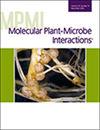Nicholas Rhoades, Todd A Naumann, Hye-Seon Kim, Gabdiel Yulfo-Soto, Susan McCormick, Michael J Bowman, Martha Vaughn, Guixia Hao
求助PDF
{"title":"An RGAE Homolog in <i>Fusarium graminearum</i> Is Critical for Initial Infection in Wheat and Barley.","authors":"Nicholas Rhoades, Todd A Naumann, Hye-Seon Kim, Gabdiel Yulfo-Soto, Susan McCormick, Michael J Bowman, Martha Vaughn, Guixia Hao","doi":"10.1094/MPMI-03-25-0027-R","DOIUrl":null,"url":null,"abstract":"<p><p><i>Fusarium graminearum</i> is the primary causal agent of Fusarium head blight (FHB), a devastating fungal disease on wheat, barley, and other grains. During infection, <i>F. graminearum</i> produces trichothecene mycotoxins, predominately deoxynivalenol (DON), that contaminate grain and reduce grain yield and quality. Although DON functions as a virulence factor to promote <i>F. graminearum</i> spread in the wheat head, it is not essential for establishing initial infection in wheat or barley. When fungal pathogens, such as <i>F. graminearum</i>, infect a host plant, they secrete hundreds of protein effectors that interfere with plant immunity to promote disease. A recent study identified hundreds of putative effector-encoding genes that are conserved across six <i>Fusarium</i> species. In the current study, we selected a subset of 50 conserved effectors from <i>F. graminearum</i> PH-1 and determined their expression on wheat heads over a 7-day infection period. Gene expression analysis revealed that several genes were highly induced in wheat heads during fungal infection. One of them was a putative <u>r</u>hamno<u>g</u>alacturonan <u>a</u>cetyl<u>e</u>sterase homolog (<i>FgRGAE</i>), which was also highly induced in barley heads. FHB virulence assays showed that deletion mutants of <i>FgRGAE</i> significantly reduced initial infection and DON accumulation in wheat and barley heads compared with wild-type controls. Replacing the <i>FgRGAE</i>::<i>Hyg</i> deletion construct with an <i>FgRGAE<sup>ORF+</sup></i>::<i>Gen</i> construct at the native locus restored FHB disease to wild-type levels in both wheat and barley heads. <i>FgRGAE</i> may serve as an ideal target to reduce FHB and mycotoxin contamination in wheat and barley. [Formula: see text] Copyright © 2025 The Author(s). This is an open access article distributed under the CC BY-NC-ND 4.0 International license.</p>","PeriodicalId":19009,"journal":{"name":"Molecular Plant-microbe Interactions","volume":" ","pages":"MPMI03250027R"},"PeriodicalIF":3.4000,"publicationDate":"2025-10-06","publicationTypes":"Journal Article","fieldsOfStudy":null,"isOpenAccess":false,"openAccessPdf":"","citationCount":"0","resultStr":null,"platform":"Semanticscholar","paperid":null,"PeriodicalName":"Molecular Plant-microbe Interactions","FirstCategoryId":"99","ListUrlMain":"https://doi.org/10.1094/MPMI-03-25-0027-R","RegionNum":3,"RegionCategory":"生物学","ArticlePicture":[],"TitleCN":null,"AbstractTextCN":null,"PMCID":null,"EPubDate":"","PubModel":"","JCR":"Q2","JCRName":"BIOCHEMISTRY & MOLECULAR BIOLOGY","Score":null,"Total":0}
引用次数: 0
引用
批量引用
Abstract
Fusarium graminearum is the primary causal agent of Fusarium head blight (FHB), a devastating fungal disease on wheat, barley, and other grains. During infection, F. graminearum produces trichothecene mycotoxins, predominately deoxynivalenol (DON), that contaminate grain and reduce grain yield and quality. Although DON functions as a virulence factor to promote F. graminearum spread in the wheat head, it is not essential for establishing initial infection in wheat or barley. When fungal pathogens, such as F. graminearum , infect a host plant, they secrete hundreds of protein effectors that interfere with plant immunity to promote disease. A recent study identified hundreds of putative effector-encoding genes that are conserved across six Fusarium species. In the current study, we selected a subset of 50 conserved effectors from F. graminearum PH-1 and determined their expression on wheat heads over a 7-day infection period. Gene expression analysis revealed that several genes were highly induced in wheat heads during fungal infection. One of them was a putative r hamnog alacturonan a cetyle sterase homolog (FgRGAE ), which was also highly induced in barley heads. FHB virulence assays showed that deletion mutants of FgRGAE significantly reduced initial infection and DON accumulation in wheat and barley heads compared with wild-type controls. Replacing the FgRGAE ::Hyg deletion construct with an FgRGAEORF+ ::Gen construct at the native locus restored FHB disease to wild-type levels in both wheat and barley heads. FgRGAE may serve as an ideal target to reduce FHB and mycotoxin contamination in wheat and barley. [Formula: see text] Copyright © 2025 The Author(s). This is an open access article distributed under the CC BY-NC-ND 4.0 International license.
小麦和大麦镰刀菌RGAE同源物是小麦和大麦初侵染的关键。
小麦赤霉病是小麦、大麦和其他谷物的一种毁灭性真菌病——赤霉病(Fusarium head blight, FHB)的主要病原体。在感染过程中,F. graminearum产生毛霉毒素,主要是脱氧雪腐镰刀菌醇(脱氧雪腐镰刀菌醇,DON),污染粮食,降低粮食产量和品质。虽然DON作为毒力因子促进禾粒镰刀菌在小麦穗内的传播,但对于在小麦或大麦中建立初始感染并不是必需的。当真菌病原体,如F. graminearum感染寄主植物时,它们会分泌数百种蛋白质效应物,干扰植物免疫从而促进疾病。最近的一项研究确定了数百个可能的效应编码基因,这些基因在6种镰刀菌中保守存在。在目前的研究中,我们从F. graminearum PH-1中选择了50个保守效应子,并在7天的感染期内测定了它们在小麦穗上的表达。基因表达分析表明,在真菌侵染过程中,多个基因在小麦穗中被高度诱导。其中一个是假定的鼠李糖半乳糖酸乙酰酯酶同源物(FgRGAE),它也在大麦穗中高度诱导。FHB毒力测定表明,与野生型对照相比,FgRGAE缺失突变体显著降低了小麦和大麦头的初始感染和DON积累。用FgRGAEORF+::Gen结构替换本地基因座上的FgRGAE::Hyg缺失结构,使小麦和大麦的FHB病恢复到野生型水平。FgRGAE可作为减少小麦和大麦中FHB和霉菌毒素污染的理想靶点。
本文章由计算机程序翻译,如有差异,请以英文原文为准。

 求助内容:
求助内容: 应助结果提醒方式:
应助结果提醒方式:


